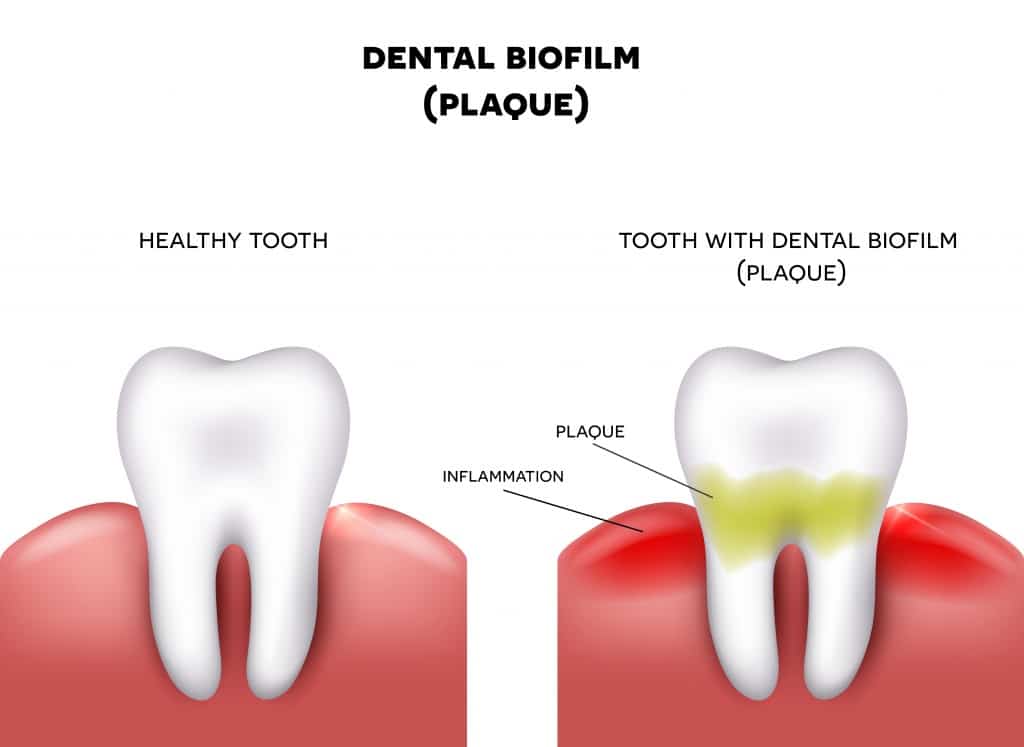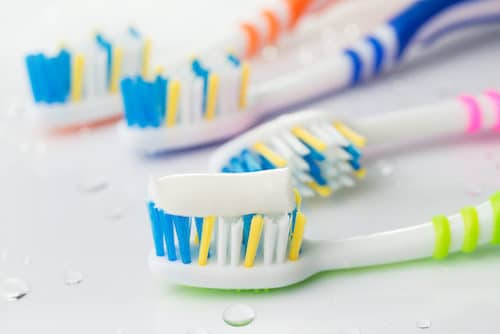
Plaque occurs when bacteria build up on your teeth. When you eat and drink, bacteria go to work metabolizing the sugars and starches in the food, leaving a scaly substance on the enamel. Over time, the plaque hardens and becomes tartar, which is more difficult for dentists to remove. Plaque and tartar break down tooth enamel and can cause tooth lesions—cavities—or problems with your gums. The techniques used to remove plaque and tartar depends on the thickness of the buildup, your overall oral health and whether or not you have any cavities or gum disease.
First Line of Defense: Good Dental Hygiene At Home
Dental visits go a long way towards preventing tartar buildup, and dentists can fix dental problems you have. However, removing plaque and preventing tartar starts with you. The best way to prevent the build-up of plaque and tartar is by practicing good dental hygiene at home. This means brushing twice a day—once in the morning and once at night—and flossing once a day, usually at night. You’ll have the best results if you brush for two minutes at each session. It’s also helpful to avoid sugary foods and drinks, which will increase bacteria growth.
Maintain a Routine
The best way to brush and floss regularly is to make it as easy as possible, and to make it part of your everyday routine. If you have trouble remembering, place your toothbrush or floss in a very visible location, or place a reminder somewhere you will see it, such as your phone or on a sticky-note. If you have a hectic morning routine, or you are exhausted at night, consider making time at another point in the day. You might brush your teeth when you get to work or school in the morning, after a meal, or before leaving in the evening.
 Upgrade Your Toothbrush or Floss
Upgrade Your Toothbrush or Floss
If you have trouble reaching parts of your mouth while brushing or flossing, consider upgrading your toothbrush or floss. An ultrasonic toothbrush uses fast-moving, spinning heads to remove more plaque. A water flosser eliminates the need for floss, or a floss pick can help you reach difficult spots.
Avoid Sugary Foods
Avoiding sugary foods is good for your health in general, but we all like to indulge sometimes. If you have a sugary soda, fruit juice, coffee or other sweet drinks, drink water along with it or after to rinse some of the sugar off your teeth. When enjoying a sugary snack, also drink water. Remember that some foods have more sugar than you might expect. For example, breakfast cereals, cocktails, and fruits all contain a lot of sugar.
Preventing Tartar Build-up With Regular Dental Appointments
Even with very strict dental care at home, some plaque and tartar buildup is inevitable. Your dentist uses specialized techniques to remove plaque and tartar, so it doesn’t develop into cavities or infections. The technique your dentist uses to remove plaque will depend on how much has built up, and whether it is above or below the gumline.
 Exam
Exam
To remove tartar and plaque effectively, your dentist first has to know exactly where the deposits are. Some of these are visible above the gumline, while others will require a closer inspection. During an exam, your dentist may take x-rays of your teeth to see the position of your teeth, but also look for cavities and tartar deposits. They will also check the “sulcus,” the tiny spaces between your teeth and gums, using a special instrument. If the sulci are deep, it’s a sign that bacteria have made their way below the gums and may be causing gum disease. With an exam, your dentist will get a good overview of your current dental health and procedures that can help to solve any problems.
Scraping
During your check-up with the dentist, the dental care professionals will use small dental tools to scrape tartar off your teeth. These small tools are pointed at one end. Some are curved to reach around the curved surfaces of your teeth. As the dentist works, you may hear a soft scraping or grinding sound as the metal tool meets the hardened tartar. If the tartar is close to the gum tissue, you might notice some sensitivity or bleeding in your mouth. All of this is normal, and means even the hard-to-reach tartar is being removed.
Root Scaling
If you skip a visit to the dentist or do not brush your teeth often enough, you may develop tartar that extends below the surface of your gums. This tartar must be removed because it could cause an infection in your tooth or the soft tissues in your mouth. The process of removing this deep tartar is called root scaling. Small tools are used to remove the tartar. You may be given a topical numbing medication to relieve any discomfort that this specialized dental cleaning technique may cause.
Fluoride or Sealants
Tooth enamel, the tough substance coating the surface of your teeth, is primarily made of minerals, mostly calcium phosphate. Bacteria in plaque break down tooth enamel and, though your saliva can remineralize tooth enamel to some degree, it might not be enough. This is especially true for children, who are often still developing good dental habits and enjoying sugary foods. Children and some adults receive fluoride treatments to restore tooth enamel. Fluoride combines with the calcium phosphate in tooth enamel to strengthen and restore it, much like saliva does naturally. Adults generally don’t receive fluoride treatments, but instead use fluoride toothpaste and drink fluoridated water to keep teeth strong.
Children may also receive dental sealants at the dentist’s office. Like fluoride treatments, dental sealants are seldom given to adults, but sealants can stop early tooth decay in children. Dental sealants consist of a thin layer of resin that covers vulnerable teeth and prevents bacteria from getting in. This way, plaque and tartar may build up on the resin, but won’t harm the teeth.
To remove tartar and plaque buildup, you should see your dentist twice a year. Don’t let your budget be a barrier to quality dental care. Look for the best teeth cleaning deals in Las Vegas and contact us to learn more about pricing and payment plans.
For more information on teeth cleaning deals in Las Vegas for yourself or a family member, take a look at our new patient special. Our experienced professionals are happy to give you more information about your appointment or any other questions you may have.

 Upgrade Your Toothbrush or Floss
Upgrade Your Toothbrush or Floss Exam
Exam